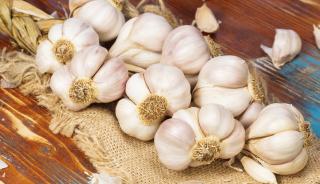Advertisement
We planted garlic last fall at our farm on the western slope of New Mexico’s Sangre de Cristos. It slept through winter and began poking through the rye cover crop and late snows this spring. In summer, to assist the garlic’s progress, I ripped out the rye that towered over it and the arabesques of vetch that stitched through it. The garlic responded with a vigorous final month of growth before the leaves began turning yellow, signaling its time had come.
In late July, we pulled almost 900 plants of softneck garlic—you can’t braid the hardneck kind, although it has its own charms—and covered nearly every flat surface in the barn with it, laid out to dry.
We gave it a week. To braid garlic, the leaves need to be dry, but not too dry. Friends arrived for a braiding bee, and we sat together catching up on our lives and processing garlic:
First, you rub off the dried mud and outer skin, and trim away roots, until you have a clean, white bulb with a blush of purple at the end of a sheaf of linear leaves.
Next, you tie three bulbs together. Remembering how you used to braid your daughter’s shining hair, you hold the bulb on the left and cross its leaves across the leaves of the center bulb; then the right bulb’s leaves are crossed across the leaves in the middle. Left becomes center, center now left; right becomes center, center now right; back and forth until the rhythmic pattern begins to appear.
You add another bulb to the middle and cross the left-most leaves over that fat double bunch of leaves in the center, then the right over the center, and so on until you have a bouquet of bulbs along a braided rope of leaves. When the strand is your idea of the perfect length, you tie it off tightly (the leaves will shrink as they dry, and you want the string to stay in place), then make a loop to hang it and display your icon of an abundant harvest and a well-stocked kitchen.
After a while, fingers cramp with the work. Our friends leave, departing with smiles and braids of garlic as they rub arthritic knuckles. As time and hand strength permits, I return to the work alone.
My cleaning of the garlic is a caress, a gesture of affectionate relationship with the voluptuous bulbs that have grown so beautiful and strongly flavored in our dark, rich soil, visited by muscular worms, watered with snowmelt, vigorous in the 40-degree diurnal thermal seesaw of warm days, cool nights. I decorate some of the plaits with feathery heads of rye and fragrant lavender. They are harvest rosaries, prayer beads of gratitude and supplication.
Neighbors pay a visit, two brothers in their eighties who grew up in this place when there were no fences to mark property lines. “How did they keep the goats out of the gardens?” I ask. “Little boys,” comes their answer.
Their visit is one of condolence. Our son, who’d not yet rounded his third decade, is buried in the oak grove, taken from us this spring by a terrible, preventable accident. One of our friends, a miner for most of his working life, recounts at length the mishap in a drift a half mile deep that almost killed him. He knows that razor-sharp boundary between life and death.
My husband tells the brothers about our braiding project. “Oh, yeah, trenzas,” they say, using the Spanish word for braids. “People used to do that all the time—garlic, onions, corn.”
A few days later, we are with a Dutch friend who has an ear for vocabulary born of the lifelong practice of seeking meaning across language barriers. We tell him about our garlic braids, and he says, musing, “trenzas.” He shares with us a story told him by a norteña friend: that making trenzas is a metaphor for bringing people together, building community, making something stronger when you wrap strands together. The act of it, the shape of it, is a form of prayer.
The fractured halves of our son’s family came together at his death. With his spirit at the center, we lapped ours over his, left over middle, middle becoming left, right over middle, middle becoming right, creating strength to bear his loss. The chaplains and medical staff, and then so many family and friends bearing casseroles, sending cards, delivering wordless hugs—all of them added themselves to the trenza. We didn’t know how strong a community we had until we found ourselves in the middle of this beautiful braid of caring.
